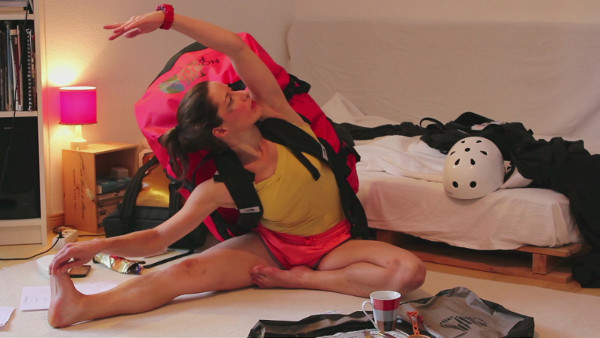Stefan Panhans
19 Jan - 16 Mar 2014
STEFAN PANHANS
Too Much Change is not Enough
19 January – 16 March 2014
Curated by Stefan Panhans and Katja Blomberg
Since the turn of the millennium we find ourselves at the turning point of a historic sea change in the media. Such times – recurring as they are through the ages – witness the development of a radically altered concept of a subject. At the transition from the analogue to the digitally globalised media world Panhans observes the increasingly porous border between the inner and the outer, between private and public spheres. Panhans detects in the, by now, completely transparent person a fundamental, paranoid strand of subjectivity, which he brings out with a keen eye for fears and compulsions.
Panhans prefers to observe his protagonists in cramped, stage-like conditions, in which they seem totally at ease with themselves while betraying a certain obsessiveness in the language they use or the optimized fitness exercises they undertake. A young woman, for example, rapidly recites food dishes on a menu and finishes by performing a counterbalancing yoga exercise, as if she wanted to compensate for the exaggerated speed of the words by doing some stretching. In “40 Zimmermädchen” (2007) a woman sits bolt upright in a police uniform by a campfire, musing on Ayurvedic diet. She is the heroine of the contemporary perception of women. Across from her sits, his long hair tousled, the male anti-hero of a fairy-tale Western, whittling a stick, seemingly receiving electronic messages from off the screen. Both appear to be hooked up to invisible data networks. The viewer is served a disturbing reminder of how deep he is already enmeshed in the absurdity of a heteronomous existence.
Panhans always works with a stationary camera. There are no cuts, pans or tilts, no zoom. Only in the background there is a little snowfall, a fire guttering, a passing car or people pushing through narrow railway compartments. All activity seems suspended. The usual shock of the cut fails to materialise. The result is a “time-image” rather than a traditional film narrative. Image and text have swapped their conventional function: language becomes the entity that provides the image. The artist brings unconscious thought to light through language. In this respect the spoken word is similar to the forming of a thought, the illogical aspects of dreams or the automatic notation of thoughts in various tempi: strung together, speeded up, fragmented or assembled.
The exhibition displays works from the last ten years as well as some created specifically for Haus am Waldsee.
Too Much Change is not Enough
19 January – 16 March 2014
Curated by Stefan Panhans and Katja Blomberg
Since the turn of the millennium we find ourselves at the turning point of a historic sea change in the media. Such times – recurring as they are through the ages – witness the development of a radically altered concept of a subject. At the transition from the analogue to the digitally globalised media world Panhans observes the increasingly porous border between the inner and the outer, between private and public spheres. Panhans detects in the, by now, completely transparent person a fundamental, paranoid strand of subjectivity, which he brings out with a keen eye for fears and compulsions.
Panhans prefers to observe his protagonists in cramped, stage-like conditions, in which they seem totally at ease with themselves while betraying a certain obsessiveness in the language they use or the optimized fitness exercises they undertake. A young woman, for example, rapidly recites food dishes on a menu and finishes by performing a counterbalancing yoga exercise, as if she wanted to compensate for the exaggerated speed of the words by doing some stretching. In “40 Zimmermädchen” (2007) a woman sits bolt upright in a police uniform by a campfire, musing on Ayurvedic diet. She is the heroine of the contemporary perception of women. Across from her sits, his long hair tousled, the male anti-hero of a fairy-tale Western, whittling a stick, seemingly receiving electronic messages from off the screen. Both appear to be hooked up to invisible data networks. The viewer is served a disturbing reminder of how deep he is already enmeshed in the absurdity of a heteronomous existence.
Panhans always works with a stationary camera. There are no cuts, pans or tilts, no zoom. Only in the background there is a little snowfall, a fire guttering, a passing car or people pushing through narrow railway compartments. All activity seems suspended. The usual shock of the cut fails to materialise. The result is a “time-image” rather than a traditional film narrative. Image and text have swapped their conventional function: language becomes the entity that provides the image. The artist brings unconscious thought to light through language. In this respect the spoken word is similar to the forming of a thought, the illogical aspects of dreams or the automatic notation of thoughts in various tempi: strung together, speeded up, fragmented or assembled.
The exhibition displays works from the last ten years as well as some created specifically for Haus am Waldsee.

